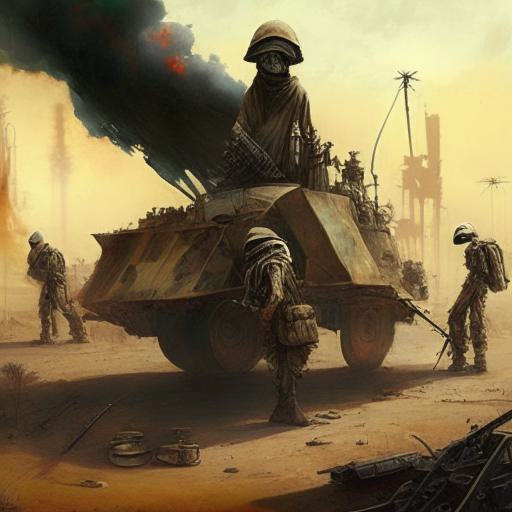
Geopolitical Struggles: Unraveling the Implications of Oil Wars
The Unintended Consequences of the Oil Wars and Global Dependence
As the US and Saudi Arabia continue their attempts to destabilize Russia through the manipulation of oil prices, they may inadvertently create a series of unintended consequences that impact the global economy. The oil price war has already led to significant job losses in the US shale industry, strained the budgets of oil-dependent countries like Saudi Arabia, and disrupted markets that depend on stable oil prices. Over the longer term, these actions risk a decline in US energy independence built up over the last decade through shale oil production. A weakened Saudi economy could also threaten the stability of global oil supplies as the kingdom accounts for over 10% of total world oil exports.
The oil wars highlight the risks of excessive dependence on finite resources with volatile prices. Many developing countries rely heavily on oil revenues for government budgets and economic growth. However, lower oil prices threaten their stability and progress. Meanwhile, oil-importing nations become vulnerable when oil prices spike. The current price war shows how easily oil markets can be disrupted, with ripple effects for the entire global economy. Governments and businesses must diversify energy sources and reduce oil dependence to build resilience against the boom and bust cycles of the oil wars.
The Rise of Renewable Energy and Diversification
Renewable energy sources like solar and wind power have grown significantly in recent years. Several factors are driving this trend: falling costs as solar panels and wind turbines have declined in price; government policies that provide incentives to adopt renewables; concerns about climate change motivating the shift to cleaner energy; energy security as countries seek to diversify energy supplies; and technological advances that have made renewables more efficient and productive.
The growth of renewable energy shows that a transition to a more sustainable energy system is possible. However, major challenges remain regarding intermittency, energy storage and grid infrastructure. Still, the trend suggests that renewable energy sources will continue to expand their share of the global energy mix in the coming decades – helping reduce dependence on fossil fuels and contributing to a more sustainable future.
The Changing Geopolitical Landscape
The oil wars have altered geopolitics by forging new alignments and challenging the established world order. Here are some key ways:
• The Russia-China-Iran axis – The oil wars have brought Russia, China and Iran closer together in a strategic alliance. They have increased economic, political and military cooperation to counter US influence. This axis now poses a united front that seeks to reshape the global order.
• A multipolar world – China’s rise and Russia’s resurgence have made the world more multipolar with multiple centres of power instead of just American dominance. This shift in the balance of power could lead to more geopolitical competition and instability.
• Strained US alliances – The US alliances with European and Gulf states have strained due to disagreements over the oil wars. This has weakened Western unity and cohesion, leaving the US with fewer reliable partners.
• Increased tensions – Geopolitical tensions have risen between the US and its allies on one side and the Russia-China axis on the other. There is now more strategic rivalry and jostling for influence among the major powers.
• Need for diplomacy – With no single dominant power, all nations must rely more on diplomacy, negotiation and international institutions to resolve disputes. Cooperation is urgently needed to tackle common challenges like climate change and pandemics.
In summary, the oil wars have accelerated the transition to a more multipolar world with weakened American influence. While this may create a more balanced international order, it also brings risks of instability and conflict among the major powers. All nations must pursue diplomacy and cooperation to navigate this changing geopolitical landscape.
The Need for a New Global Energy Strategy
The oil wars have exposed the vulnerabilities and unsustainability of the current global energy system dominated by fossil fuels. To prevent future conflicts and crises, there is an urgent need for a new international energy strategy with the following elements:
• A rapid transition to renewable energy – The world must accelerate the shift to renewable sources like solar and wind to reduce dependence on oil and gas. This will require massive investment in clean technologies and infrastructure and industry changes.
• Diversification of energy supplies – Individual countries must diversify their energy sources and imports to avoid over-reliance on a single nation or resource. This will make energy systems more resilient to shocks and geopolitical manipulation.
• Increased energy efficiency – All countries must pursue aggressive policies to improve energy efficiency and conservation to reduce the overall demand for fossil fuels. This includes better insulation, appliances and manufacturing processes.
• Greater international cooperation – Nations must cooperate more closely on energy research, technology sharing, cross-border infrastructure and policy coordination. This is needed to manage the transition to a sustainable energy system.
• Multilateral governance frameworks – Strong multilateral institutions are needed to set global standards, monitor progress and resolve disputes in the energy sector. This could help reduce geopolitical tensions and competition over resources.
The Oil Wars: A Retrospective (2015-2023)
The oil wars refer to the period from 2015 to 2016 when a price war among major oil producing nations led to a collapse in global oil prices. The price war began when the US and Saudi Arabia pursued a strategy to flood the oil market to weaken Russia’s economy.
In 2014, Russia annexed Crimea and supported separatists in eastern Ukraine. In response, the US and Saudi Arabia sought to punish Russia by driving down oil prices. They increased oil production and cut costs, seeking to gain market share at Russia’s expense.
Saudi Arabia, the world’s largest oil exporter, ramped up production and offered significant discounts. This pushed Brent crude prices down to around $30 per barrel in early 2016, less than half of what they had been the year before.
The strategy had the desired effect on Russia. Its economy, which depends heavily on oil revenues, contracted as the ruble lost half of its value against the dollar. However, the price collapse also had unintended consequences:
• US shale oil producers, which rely on higher prices, struggled due to the low oil price. Thousands of jobs were lost, and many shale companies went bankrupt.
• Saudi Arabia’s budget, which also depends on high oil prices, fell into deficit. The Kingdom had to implement austerity measures and borrow funds.
• Other oil-exporting countries like Venezuela and Nigeria also faced severe economic difficulties.
By early 2017, the oil price war ended as the involved parties came to the realization that prolonged low prices were damaging their own economies. However, the oil wars demonstrated the vulnerabilities within the global oil system and the potential for geopolitical manipulation of oil markets.
The OPEC Production Cuts and the Rise of US Shale (2016-2018)
After oil prices collapsed in the oil wars of 2015-2016, OPEC took action to stabilize the market by cutting production. This decision had several consequences for the global oil industry:
• OPEC production cuts – In late 2016, OPEC agreed to cut around 1.2 million barrels daily to rebalance supply and demand. Saudi Arabia initially led the cuts and was later joined by non-OPEC members like Russia.
• Rising oil prices – The OPEC cuts helped push oil prices higher, with Brent crude rising from around $30 per barrel in early 2016 to over $80 by late 2018. The recovery provided relief to oil-exporting economies.
• Resurgence of US shale – The higher oil prices made US shale production profitable again. Shale companies that had cut costs could ramp up production quickly, taking advantage of the market recovery.
• US becomes the world’s largest producer – By November 2018, US crude output surpassed that of Saudi Arabia and Russia, making the US the world’s largest oil producer. US production grew by around 7 million barrels per day between 2012 and 2018, mainly from shale.
• Shift in geopolitics – The US shale boom gave the US greater energy security and independence, reducing its reliance on imported oil. The US also gained more influence in global oil markets. This marked a power shift away from OPEC and traditional oil-exporting nations.
The Impact of US Sanctions on Iran and Venezuela (2018-2020)
The US imposition of sanctions on Iran and Venezuela during this period had several effects on the global oil market and geopolitics:
• Declining Iranian and Venezuelan production – The sanctions severely restricted Iran and Venezuela’s ability to export oil and access international markets. This led to a sharp drop in their oil production, with Iran’s output falling by around 1 million barrels per day and Venezuela’s by over 500,000 barrels.
• Tighter global oil market – The loss of Iranian and Venezuelan supply contributed to a tighter oil market and higher oil prices. Brent crude rose from around $70 per barrel in 2018 to over $60 in 2019 as the sanctions began to bite. This benefited other oil producers.
• Closer Iran-Russia-China ties – In response to the sanctions, Iran drew closer to Russia and China for economic support. Both countries increased their oil imports from Iran in defiance of the US. This further cemented the Russia-China-Iran axis.
• Venezuela turns to Russia and China – Venezuela also received increased economic and military support from Russia and China to counter US sanctions and regime change efforts. Both countries gained influence in Venezuela’s oil industry.
• Escalation of geopolitical tensions – The sanctions escalated tensions between the US and both Iran and Venezuela, as well as with Russia and China. They further strained the global order and highlighted the weaponization of oil as a geopolitical tool.
The COVID-19 Pandemic and the Oil Price Crash (2020-2021)
The COVID-19 pandemic had a profound impact on the global oil market:
• Collapse in oil demand – As the pandemic spread worldwide in early 2020, oil demand plummeted due to lockdowns, travel restrictions and an economic slowdown. At one point, demand fell by around 30 million barrels per day – an unprecedented decline.
• Saudi-Russia price war – In March 2020, Saudi Arabia launched a price war with Russia by massively increasing production after Russia refused further OPEC+ cuts. This flooded the market with excess supply when demand was crashing.
• Historic oil price crash – Plummeting demand and increased supply caused oil prices to crash to historic lows in April 2020. Brent crude fell below $20 per barrel, down from over $60 at the start of the year.
• Record OPEC+ production cuts – The price crash prompted OPEC and non-OPEC allies led by Russia to agree on the largest production cuts in history. Around 10 million barrels per day were removed from the market to help rebalance supply and demand.
• Accelerated shift to renewables – The pandemic highlighted the vulnerabilities of fossil fuel-based systems, accelerating the shift towards renewable energy sources. Many governments increased investment in clean technologies.
• Need for a resilient energy system – The crisis demonstrated the need for a more sustainable and secure global energy system less prone to disruptions and price volatility. This will require diversifying energy sources and reducing dependence on oil.
The Road to Recovery and the Future of the Oil Wars (2021-2023)
As the world economy recovers from the COVID-19 pandemic:
• Oil demand has gradually rebounded, with prices stabilizing around $70-$80 per barrel. The market is rebalancing after the 2020 price crash.
• The US continues to enforce sanctions on Iran and Venezuela, limiting their oil exports. This has maintained tensions with Russia and China, who support these countries.
• Russia and China have deepened their energy cooperation, with Russia increasing oil and gas exports to China. This has further cemented their strategic alliance.
• The transition to renewable energy has gained momentum. More countries are setting net zero emissions targets and investing in clean technologies to reduce dependence on fossil fuels.
• There are calls for a new global energy strategy focused on sustainability, resilience and diversification. The vulnerabilities exposed by the oil wars and pandemic underscore this need.
• Geopolitical tensions persist in the oil market, with the US and its allies on one side and Russia, China, Iran and their allies on the other. Diplomacy will be key to avoiding further conflicts.
In summary, the oil wars from 2015 to the present have significantly impacted the global energy landscape, accelerating the transition to renewables, diversification of energy sources, and shifts in the geopolitical order. While the future remains uncertain, the road to a more sustainable and secure energy system will depend on international cooperation, technological innovation, and a new strategy that transcends the conflicts of the oil wars. The challenges are immense, but so is the opportunity to build a cleaner, more stable energy future.
Other Articles of Interest

The Mob Psychology: Why You Have to Be In It to Win It

What Is Collective Behavior: Unveiling the Investment Enigma

What is the Rebound Effect? Unlock Hidden Profits Now

Dividend Collar Strategy: Double Digit Gains, Minimal Risk, Maximum Reward

Dividend Capture Strategy: A Devilishly Delightful Way to Boost Returns

BMY Stock Dividend Delight: Reaping a Rich Yield from a Blue-Chip Gem

Define Indoctrination: The Art of Subtle Brainwashing and Conditioning

What Is the Velocity of Money Formula?

What is Gambler’s Fallacy in Investing? Stupidity Meets Greed

Poor Man’s Covered Call: With King’s Ransom Potential

How to Start Saving for Retirement at 35: Don’t Snooze, Start Now

The Great Cholesterol Scam: Profiting at the Expense of Lives

USD to Japanese Yen: Buy Now or Face the Consequences?

How is Inflation Bad for the Economy: Let’s Start This Torrid Tale

Copper Stocks: Buy, Flee, or Wait?
Freedom and Independence Dec 22, 2014
Alternative ViewPoints Dec 21, 2014
The Observer or the Participator
Financial Insights: Cutting Through the Noise


